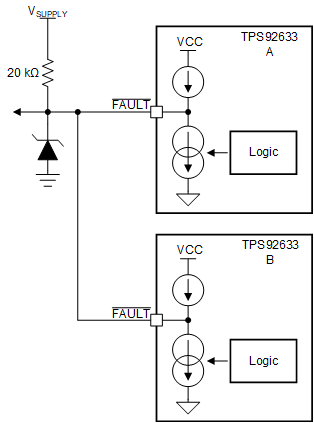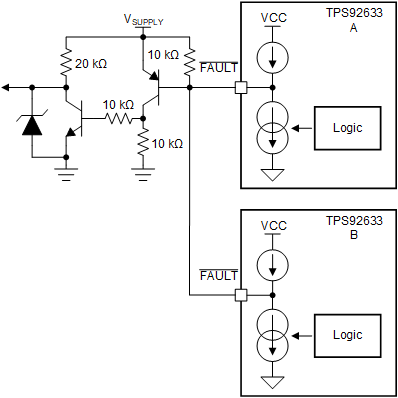JAJSKJ6 June 2021 TPS92633
PRODUCTION DATA
- 1 特長
- 2 アプリケーション
- 3 概要
- 4 Revision History
- 5 Pin Configuration and Functions
- 6 Specifications
-
7 Detailed Description
- 7.1 Overview
- 7.2 Functional Block Diagram
- 7.3
Feature Description
- 7.3.1 Power Supply (SUPPLY)
- 7.3.2 Enable and Shutdown (EN)
- 7.3.3 Reference Current (IREF)
- 7.3.4 Constant-Current Output and Setting (INx)
- 7.3.5 Analog Current Control (ICTRL)
- 7.3.6 Thermal Sharing Resistor (OUTx and RESx)
- 7.3.7 PWM Control (PWMx)
- 7.3.8 Supply Control
- 7.3.9
Diagnostics
- 7.3.9.1 IREF Short-to-GND Detection
- 7.3.9.2 IREF Open Detection
- 7.3.9.3 LED Short-to-GND Detection
- 7.3.9.4 LED Open-Circuit Detection
- 7.3.9.5 Single LED Short-Circuit Detection (SLS_REF)
- 7.3.9.6 LED Open-Circuit and Single LED Short-Circuit Detection Enable (DIAGEN)
- 7.3.9.7 Low Dropout Operation
- 7.3.9.8 Over-Temperature Protection
- 7.3.10 FAULT Bus Output With One-Fails–All-Fail
- 7.3.11 FAULT Table
- 7.3.12 LED Fault Summary
- 7.3.13 IO Pins Inner Connection
- 7.4 Device Functional Modes
- 8 Application and Implementation
- 9 Power Supply Recommendations
- 10Layout
- 11Device and Documentation Support
- 12Mechanical, Packaging, and Orderable Information
7.3.10 FAULT Bus Output With One-Fails–All-Fail
During normal operation, The FAULT pin of TPS92633 is weakly pulled up by an internal pullup current source, I(FAULT_pullup). If any fault scenario occurs, the FAULT pin is strongly pulled low by the internal pulldown current sink, I(FAULT_pulldown) to report out the fault alarm.
Meanwhile, the TPS92633 also monitors the FAULT pin voltage internally. If the FAULT pin of the TPS92633 is pulled low by external current sink below VIL(FAULT), the current output is turned off even though there is no fault detected on owned outputs. The device does not resume to normal operation until the FAULT pin voltage rises above VIH(FAULT).
Based on this feature, the TPS92633 device is able to construct a FAULT bus by tying FAULT pins from multiple TPS92633 devices to achieve one-fails-all-fail function as Figure 7-12 showing. The lower side TPS92633 (B) detects any kind of LED fault and pulls low the FAULT pin. The low voltage on FAULT pin is detected by upper side TPS926133-Q1 (A) because the FAULT pins are connected of two devices. The upper side TPS92633 (A) turns off all output current for each channel as a result. If the FAULT pins of each TPS92633 are all connected to drive the base of an external PNP transistor as illustrated in Figure 7-13, the one-fails–all-fail function is disabled and only the faulty channel is turned off.
 Figure 7-12 FAULT Bus for One-Fails-All-Fail
Application
Figure 7-12 FAULT Bus for One-Fails-All-Fail
Application Figure 7-13 FAULT Bus for One-Fails-Others-On
Application
Figure 7-13 FAULT Bus for One-Fails-Others-On
Application